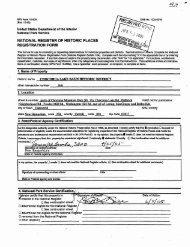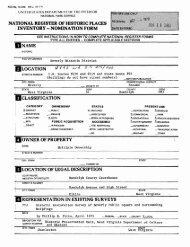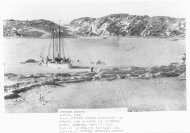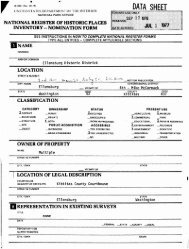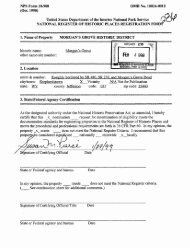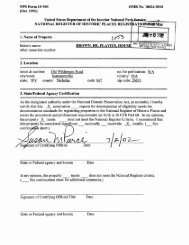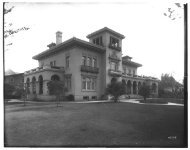National Register of Historic Places Inventory Nomination Form
National Register of Historic Places Inventory Nomination Form
National Register of Historic Places Inventory Nomination Form
Create successful ePaper yourself
Turn your PDF publications into a flip-book with our unique Google optimized e-Paper software.
FHR-8-300 (11-78)<br />
United States Department <strong>of</strong>f the Interior<br />
Heritage Conservation and Recreation Service<br />
<strong>National</strong> <strong>Register</strong> <strong>of</strong> <strong>Historic</strong> <strong>Places</strong><br />
<strong>Inventory</strong> No|t]ifnation <strong>Form</strong><br />
Royal Typewriter Building<br />
Continuation sheet_____________________Item number 8____________Page 5______<br />
motorizing each machine. Until then, whole machining departments were<br />
vulnerable to breakdowns if an overhead shaft failed to operate. This<br />
conversion also made working conditions safer "by eliminating the exposed,<br />
high-speed "belts.<br />
A major part <strong>of</strong> manufacturing at the Royal plant was the production <strong>of</strong><br />
special-purpose parts and machinery. One example is the "39 Spindle<br />
Machine", which "drilled, tapped, reamed .all the holes in a typewriter<br />
frame in a single clamping <strong>of</strong> the piece"5.<br />
The 1950s also marked a decade <strong>of</strong> continued expansion in both the<br />
physical plant and in the line <strong>of</strong>,production. A new factory was built<br />
in West Hartford for the manufacture <strong>of</strong> "Roytype" carbon paper and ribbon.<br />
In 1950 Royal introduced its first electric typewriter. Four years later<br />
the company merged with the McBee Company, an <strong>of</strong>fice supply manufacturer<br />
in Athens, Ohio. The merge would significantly broaden Royal's financial<br />
base and lead the company into the production <strong>of</strong> <strong>of</strong>fice machines other<br />
than typewriters. In I960 Royal-McBee began production <strong>of</strong> its own transfer-<br />
copier machine, resulting in the formation <strong>of</strong> a subsidiary company,<br />
Royal Copier Systems. In 1965 Royal-McBee was taken over by Litton Indus<br />
tries, which separated production responsibilities and launched the<br />
whole industry into a highly complex series <strong>of</strong> international corporate<br />
reorganizations extending to England, Germany, and Japan, and involving<br />
the purchase <strong>of</strong> controlling interest by the German Triumph-Adler Corporation.<br />
By 1972, the Hartford plant was no longer to sustain manufacturing opera<br />
tions, and all production was-moved to England.<br />
Today the Parkville plant serves as a warehouse, and quarters: for <strong>of</strong>fices,<br />
training, machine-testing, and some servicing. R'.oyal Business Machines, Inc.,<br />
as the division is known today, produces a diverse line <strong>of</strong> <strong>of</strong>fice machines,<br />
such as calculators, word-processors, and small computers. This equipment<br />
is manufactured in Germany and Japan.<br />
Owing to changing company needs and the rising cost <strong>of</strong> fuel, Royal Business<br />
Machines has sold the Parkville plant to the Bronson-Hutinsky Company <strong>of</strong><br />
Bloomfield, Connecticut. The building is currently under lease from the<br />
latter and will change occupants in December <strong>of</strong> 1981. Royal will transfer<br />
its Hartford operations to newly-built quarters in Bloomfield.<br />
Since the demolition <strong>of</strong> the Underwood Typewriter plant, the Royal factory<br />
is Hartford's largest remaining example <strong>of</strong> 19th-century mill- type construc<br />
tion. Today the highly visible structure stands as a powerful visual reminder<br />
<strong>of</strong> the vital role <strong>of</strong> the city in the small-parts and machine tool industry<br />
<strong>of</strong> the Northeast after the Civil War. The factory's presence gives historical<br />
meaning to the Parkville section <strong>of</strong> Hartford, and is the only remaining<br />
structure from the great typewriter industry <strong>of</strong> the early 20th-century in<br />
Hartford.



